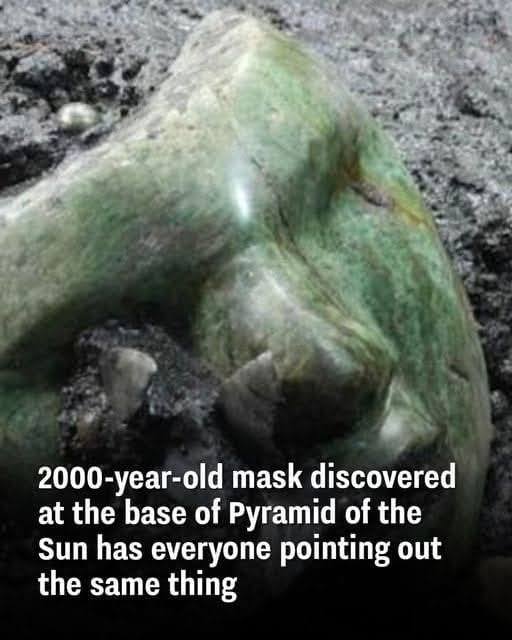In 2011, a groundbreaking discovery took place within the depths of the Pyramid of the Sun in Teotihuacan, Mexico. During an excavation led by Mexico’s National Institute of Anthropology and History (INAH), archaeologists accessed the lower levels of the pyramid through a tunnel originally dug in the 1930s. Among the variety of artifacts uncovered—ceramic fragments, animal bones, and three human figurines—one object stood out: an intricately carved green mask. This remarkable artifact, with its lifelike details and polished craftsmanship, is believed to represent the face of a significant figure from Teotihuacan society.

Dr. Pérez Cortez, one of the lead archaeologists from INAH, described the significance of the discovery. According to him, the mask, along with the accompanying offerings, was likely part of a dedication ritual performed at the start of the pyramid’s construction. These ceremonial practices were essential in ancient Mesoamerican culture, symbolizing spiritual blessings for monumental projects. The mask, carved from green serpentine stone, carries not only artistic value but also deep spiritual meaning. It provides researchers with invaluable insights into the belief systems and rituals of the people who built one of the ancient world’s largest pyramids.
Teotihuacan, often referred to as the “City of the Gods,” remains one of Mesoamerica’s most enigmatic civilizations. Located northeast of modern-day Mexico City, this ancient urban center flourished between 100 BCE and 600 CE, at its peak housing an estimated population of 200,000. Its expansive layout, sophisticated urban planning, and towering monuments, including the Pyramid of the Sun and the Pyramid of the Moon, have long fascinated historians and archaeologists. Despite its prominence, much about Teotihuacan remains shrouded in mystery, including its original name, the identity of its rulers, and the reasons behind its eventual decline.
The discovery of the green mask adds another layer to the puzzle. It was found alongside ceremonial offerings, including animal skulls encrusted with volcanic rock, suggesting strong symbolic ties to fertility, power, and divine protection. The artifacts reveal that rituals played a central role in Teotihuacan’s society, with leaders and builders seeking spiritual favor for the success of their endeavors. Every detail carved into the mask seems intentional, possibly reflecting the likeness of a ruler or deity central to these ceremonies.
However, the historical significance of the mask hasn’t stopped it from capturing the imagination of modern audiences in unexpected ways. Its striking green color and expressive facial features have led to lighthearted comparisons online. Social media users have drawn parallels between the ancient artifact and the famous green-faced character from Jim Carrey’s 1994 film The Mask. Comments such as “Sssssmokin’!” and “Somebody stop me!” have flooded online discussions about the discovery. While these playful remarks bring humor to the conversation, they also highlight the mask’s ability to bridge ancient history with contemporary culture.
But beyond the viral jokes and memes lies the true value of this discovery. The green serpentine mask stands as a testament to the artistry, craftsmanship, and cultural depth of Teotihuacan society. It represents the meticulous skill of artisans who carved it and the reverence with which it was placed within the pyramid as part of sacred rituals. Each groove and polished surface of the mask carries echoes of a civilization that once stood at the forefront of ancient innovation and cultural expression.
As researchers continue to study the Pyramid of the Sun and its buried treasures, the green mask serves as a powerful symbol of the enduring mysteries of Teotihuacan. It reminds us of the spiritual connections the city’s builders sought with their gods, their ancestors, and their monumental structures. The artifacts found alongside the mask also hint at a civilization deeply attuned to cycles of life, death, and rebirth—an understanding woven into the fabric of their rituals and architecture.
In many ways, the discovery of this mask transcends its archaeological context. It is not merely an artifact but a bridge between two worlds: the ancient and the modern. It invites us to marvel at the ingenuity of Teotihuacan’s builders while reminding us of the fragility of cultural memory. Every discovery made beneath the stones of the Pyramid of the Sun brings us closer to understanding the people who once called Teotihuacan home.
The green mask, now carefully preserved and studied, continues to captivate both experts and the public alike. It is a rare and precious link to a society whose legacy remains etched in stone, offering valuable lessons about resilience, spirituality, and the universal human desire to leave a lasting mark on history. As archaeologists press forward with their investigations, one thing remains certain: the secrets of Teotihuacan are far from fully uncovered, and each artifact—like this remarkable green mask—brings us one step closer to unraveling the mysteries of this ancient civilization.





